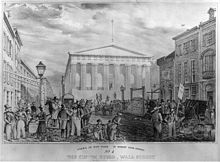United States Custom House (New York City)
40°42′26″N 74°0′37″W / 40.70722°N 74.01028°W



The United States Custom House, sometimes referred to as the New York Custom House, was the place where federal customs duties on imported goods were collected in New York City. It was later superseded by the Alexander Hamilton U.S. Custom House.
Locations
The custom house existed at several locations over the years. From 1790 to 1799, it was at South William Street, opposite Mill Lane, known as 5 Mill Street.[1][2] From 1799 to 1815, it was in the Government House, roughly on the former site of Fort Amsterdam. From 1842 it was at 26 Wall Street in a new building designed by John Frazee, today designated Federal Hall National Memorial. From 1862 it was in the Merchant's Exchange Building at 55 Wall Street. In 1907 it moved into a new building, now called the Alexander Hamilton U.S. Custom House, built on the site where Government House sat earlier, on the south side of Bowling Green. In 1973 it moved to 6 World Trade Center, which was destroyed as a result of the September 11 attacks.
Importance
In the 19th century, the Port of New York was the primary port of entry for goods reaching the United States, and as such the Custom House in New York was the most important in the country. In 1853, for instance, it collected almost 75% of the custom revenue in the country; and until the passage of the 16th Amendment in 1913, which instituted a national income tax, the New York Custom House supplied two-thirds of the federal government's revenue.[3] The amount of money passing through the Custom House made working there a prime position, as corruption was widespread. At one point, 27,000 people applied for 700 open positions in the Custom House.[4]
Patronage
Until the civil service reforms of the late nineteenth century, all Custom House employees were political appointees. The President appointed the four principal officers: Collector of Customs, Naval Officer, Surveyor of Customs, and Appraiser of Customs. The Customs House patronage was the subject of great debate during the Rutherford B. Hayes administration, as Hayes attempted to establish a merit-based system of appointments, while Senator Roscoe Conkling wished to retain the spoils system, under which he controlled the patronage there. One Collector of Customs, Chester A. Arthur (1871-1878), later became President of the United States. Arthur was said to have made several times more income as a collector than he did as a lawyer, about $50,000 a year in his first three years in office.[4]
See also
References
Notes
- ^ Stokes (1915–1928), v. 2, p. 301.
- ^ Stokes (1915–1928), v. 5, p. 1263.
- ^ Vowell, Sarah (2005). Assassination Vacation. New York: Simon & Schuster. p. 127. ISBN 9780743260039.
- ^ a b Keller, Mollie and Marton, James. "U.S. Customs Service" in Jackson, Kenneth T., ed. (2010). The Encyclopedia of New York City (2nd ed.). New Haven: Yale University Press. ISBN 978-0-300-11465-2., pp.1355-56
Sources
- Stokes, Isaac Newton Phelps (1915–1928). The Iconography of Manhattan Island, 1498–1909. Robert H. Dodd.
{{cite book}}: Invalid|ref=harv(help)
This article needs additional citations for verification. (August 2012) |
